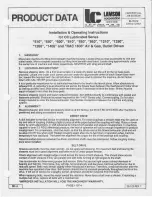
16
Engine Oil Change
Drain the oil while the engine is still warm to ensure rapid and
complete draining.
1. Place the snow blower on a level surface.
2. Place a suitable container below the engine (right side) to catch the
used oil, then remove the oil filler cap and the drain plug.
To avoid loosening the drain plug extension, hold it with a 17 mm
wrench while loosening the drain plug with a 10 mm wrench.
3. Allow the used oil to drain completely into an approved container,
reinstall the drain plug with a new sealing washer, and then tighten
it securely.
TORQUE: 13 ft-lb (18 N•m)
NOTICE
Improper disposal of engine oil can be harmful to the environment.
If you change your own oil, please dispose of used motor oil
properly. Put it in a sealed container and take it to a recycling
center. Do not throw it in the trash, pour it on the ground, or pour it
down a drain.
4. With the engine in a level position, fill to the upper limit on the
dipstick with the recommended oil (shown below). Do not thread
the dipstick in when checking the oil level. Do not overfill.
Maximum oil capacity:
1.2 US qt (37 oz, 1.1 L)
NOTICE
Running the engine with a low oil level can cause engine damage.
This type of damage is not covered by the
Distributor’s Limited
Warranty.
5. Reinstall the oil filler cap securely.
Engine Oil Recommendations
Oil is a major factor affecting performance and service life. Use a
4-stroke automotive detergent oil.
SAE 5W-30 is recommended
for general use.
The SAE oil viscosity and
service classification are on
the API label on the oil
container. Honda
recommends that you use
API SERVICE category SJ or
later (or equivalent) oil.
Spark Plug
Required spark plug:
BPR5ES (NGK) or W16EPR-U (DENSO)
NOTICE
Use only the required spark plug or equivalent. Spark plugs which
have an improper heat range may cause engine damage. Allow the
engine to cool down before removing the spark plug to avoid damage
to the spark plug threads in the cylinder head.
To ensure proper engine operation, the spark plug must be properly
gapped and free of deposits. If the engine has been running, the
muffler will be very hot. Be careful not to touch the muffler.
1. Remove the spark plug
cap.
2. Clean any dirt from
around the spark plug
base.
3. Use the spark plug
wrench supplied in the
tool kit to remove the
spark plug.
4. Inspect the spark plug.
Replace it if the
electrodes are worn or if
the insulator is cracked,
chipped, or fouled.
5. Measure the plug gap with a
wire-type feeler gauge. Adjust as
necessary by carefully bending
the side electrode.
Plug gap:
0.028–0.031 in (0.7–0.8 mm)
6. Make sure that the spark plug
sealing washer is in good
condition, and thread the spark
plug in by hand to prevent
cross-threading.
7. After the spark plug is seated,
tighten with a spark plug wrench to compress the washer.
TORQUE: 13 ft-lb (18 N•m)
If you don’t have a torque wrench, install a new spark plug and
tighten 1/2 turn after the spark plug seats to compress the washer.
If reinstalling a used spark plug, tighten 1/8 to 1/4 turn after the
spark plug seats.
NOTICE
The spark plug must be securely tightened. An improperly
tightened spark plug can become very hot and may damage the
engine.
DRAIN PLUG
SEALING WASHER
OIL FILLER
CAP
UPPER LIMIT
AMBIENT TEMPERATURE
SPARK PLUG WRENCH
SPARK PLUG CAP
SIDE ELECTRODE
0.028–0.031 in
(0.7–0.8 mm)
SEALING
WASHER
INSULATOR
Содержание HSS1332A
Страница 29: ...29 NOTES ...
Страница 30: ...30 NOTES ...
















































